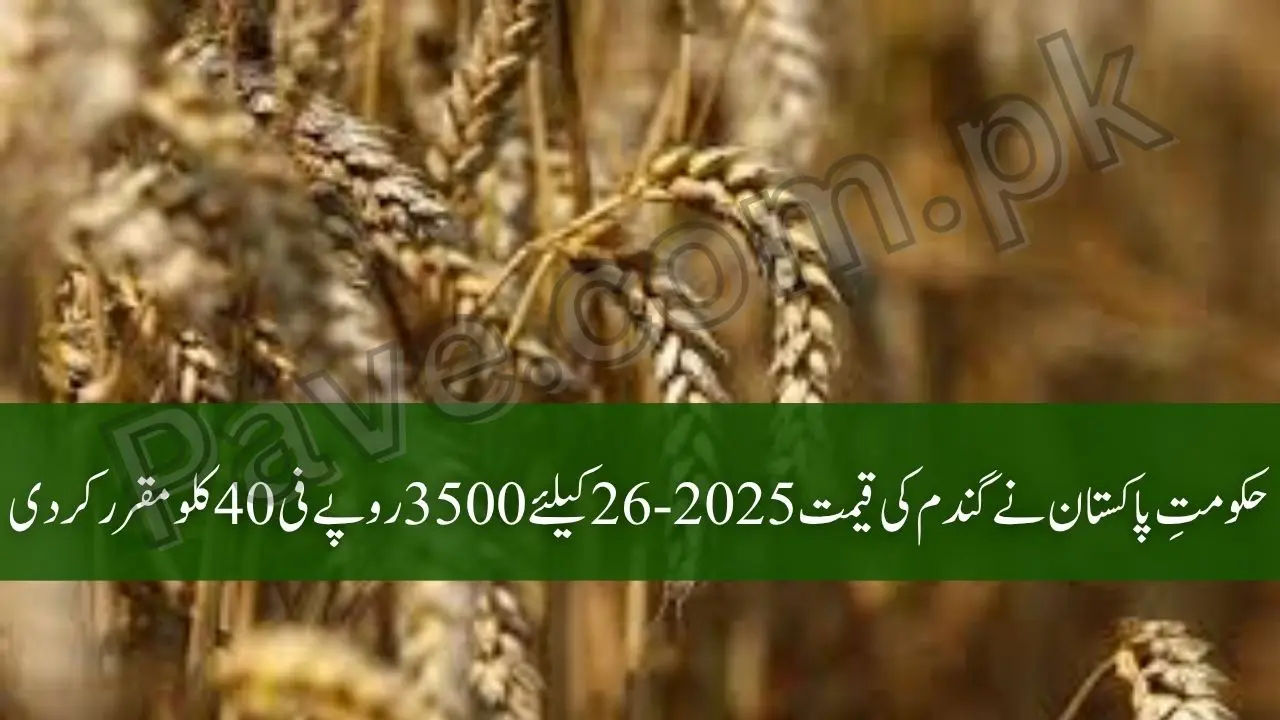Breaking News: Govt Finalizes Wheat Procurement Rate 2025-26 at Rs 3500
In a major agricultural development, the Government of Pakistan has fixed the Wheat Procurement Rate 2025-26 at Rs 3,500 per 40 kilograms under the new Wheat Policy 2025-26. The announcement was made during a high-level meeting chaired by Prime Minister Shehbaz Sharif in Islamabad on Sunday.
The move aims to ensure fair earnings for farmers, maintain national wheat reserves, and stabilize the flour market amid rising global grain prices. The policy aligns domestic support prices with international trends while protecting farmers from production-cost shocks.
🏛️ Key Features of Wheat Policy 2025-26
| Feature | Details |
|---|---|
| Support Price | Rs 3,500 per 40 KG |
| Policy Year | 2025-26 |
| Announced By | Prime Minister Shehbaz Sharif |
| Objective | Farmer welfare + food-security stability |
| Wheat Movement | Unrestricted inter-provincial transport |
| Oversight | National Food Security Committee |
| Reporting Frequency | Weekly briefings to PM |
This year’s price review focused on input-cost inflation, import parity, and regional supply gaps before finalizing the procurement rate.
⚖️ Balancing Farmers’ Welfare and Market Stability
Pakistan’s wheat policy must balance producer profits and consumer affordability. The government’s Rs 3,500 rate reflects a middle path — high enough to make wheat cultivation profitable yet low enough to prevent flour price spikes.
According to the Ministry of National Food Security, the new rate was designed to:
- Protect small and medium-scale farmers from input-cost inflation.
- Maintain flour availability at affordable prices.
- Build strategic wheat reserves to prevent future shortages.
- Reduce dependency on imported grain.
Officials emphasized that the price is close to global import parity and that timely procurement will help farmers recover rising fertilizer and fuel expenses.
Read More: Pakistan Launches “Go AI Hub” – A Major Step Toward Digital
🌍 Global Price Context
The international wheat market remains volatile due to supply disruptions in Ukraine and Russia and poor harvests in Argentina and Australia. With global prices averaging around USD 300 per ton, Pakistan’s support rate mirrors global competitiveness while keeping domestic growers protected.
By pegging prices closer to global trends, the government aims to curb smuggling, control black-market activity, and maintain transparent procurement across provinces.
🚜 Provincial Reactions
Sindh’s Concern for Higher Rates
Sindh Agriculture Minister Muhammad Bux Khan Mahar urged the federal government to raise the price to Rs 4,200 per 40 KG, claiming the current rate may not cover production costs in Sindh’s southern belt.
“Our farmers face higher fertilizer and irrigation costs. If the price remains below Rs 4,000, they may switch to other cash crops like cotton or sugarcane,”
— Muhammad Bux Khan Mahar
He warned that an uncompetitive price could reduce wheat acreage, risking a national shortage during 2026.
Punjab’s Endorsement
Punjab, which contributes over 70 percent of Pakistan’s total wheat output, endorsed the federal rate. Provincial officials said maintaining a uniform national price prevents inter-provincial smuggling and keeps flour distribution fair.
Punjab’s Food Department plans to procure over 4 million tons under the new rate, with digital monitoring of payments to ensure direct disbursement to farmers’ accounts.
Read More: Pakistan Gold Price Today 20 October 2025
💸 Sindh’s Rs 56 Billion Wheat Support Programme
In parallel, the Sindh Government launched a Rs 56 billion Wheat Cultivation Support Programme to help growers absorb higher input costs.
| Particular | Detail |
|---|---|
| Total Budget | Rs 56 billion |
| Fertilizer Subsidy | Rs 24,700 per acre |
| Eligible Farmers | 411,000 small & medium growers |
| Registered So Far | 132,000 + |
| Objective | Boost wheat acreage and yield |
This subsidy is expected to increase per-acre yield, especially in rain-fed zones and small landholdings, complementing the federal support price policy.
🧑🌾 Prime Minister’s Remarks
Prime Minister Shehbaz Sharif described the new wheat policy as a “balanced approach for sustainable food security”.
“The government will ensure that every grower receives a fair return for his hard work.
We are also strengthening reserves to protect consumers from inflation shocks,”
— PM Shehbaz Sharif
He directed provincial food departments to complete procurement within defined timelines and avoid delayed payments, a long-standing complaint among farmers.
🏢 National Oversight Mechanism
A National Wheat Coordination Committee will supervise policy implementation.
Composition:
- Federal Minister for National Food Security (Chair)
- Provincial Food Secretaries
- Representatives from Farmer Associations
- Strategic Grain Reserve Officials
Responsibilities:
- Weekly reviews of stock positions and wheat movement.
- Recommendations on release policies and imports.
- Submission of progress reports to the Prime Minister’s Office.
This structure aims to improve transparency, prevent hoarding, and maintain real-time data on stock levels.
🌾 Wheat’s Economic Significance
Wheat accounts for nearly 2 percent of Pakistan’s GDP and serves as the dietary backbone for over 220 million people. Each year, around 8.5 million hectares are dedicated to wheat cultivation, employing nearly 40 percent of the rural workforce.
However, profitability has been under pressure due to:
- Rising input costs (diesel, urea, seeds).
- Climate variability and water scarcity.
- Delays in government procurement payments.
The new policy, coupled with digital procurement reforms, aims to restore farmer trust and promote sustainable cultivation.
📈 Wheat Procurement Price Trend (Last 5 Years)
| Fiscal Year | Support Price (Rs/40 KG) | Change % |
|---|---|---|
| 2020-21 | 1,800 | — |
| 2021-22 | 2,200 | +22% |
| 2022-23 | 3,000 | +36% |
| 2023-24 | 3,900 | +30% |
| 2025-26 | 3,500 | −10% |
Source: Ministry of National Food Security & Research
The moderate reduction reflects lower fertilizer import costs, stable rupee parity, and improved domestic yield projections.
💹 Economic & Inflation Impact
Economists believe the decision will influence food inflation, as wheat and flour prices directly shape the Consumer Price Index. A controlled procurement rate helps the government manage urban inflation, though its success depends on efficient procurement.
Analyst Dr. Farah Malik noted:
“The Rs 3,500 rate is a pragmatic midpoint. It’s viable for farmers and manageable for consumers, provided procurement and payment systems remain efficient.”
She also called for smart subsidies, weather-indexed crop insurance, and digital transparency tools for long-term agricultural reform.
🧠 Policy Challenges Ahead
While the announcement offers relief, its success relies on:
- On-time payments to growers after procurement.
- Adequate storage and reduction in post-harvest losses.
- Climate resilience, particularly in drought-prone southern Punjab.
- Effective coordination between federal and provincial food departments.
The government is also considering warehouse receipt financing and public-private partnerships to modernize storage infrastructure.
🧾 Summary – Govt Finalizes Wheat Procurement Rate 2025-26 at Rs 3500
- Support price: Rs 3,500 per 40 KG.
- Policy goal: Balance between farmer profits and consumer inflation.
- Oversight: Weekly national committee reviews.
- Sindh’s initiative: Rs 56 billion fertilizer subsidy.
- Punjab’s role: Digital procurement and farmer payments.
- Expected outcome: Higher production, stable flour prices, and strong food reserves.
Read More: Good News: How to Start a Business from Home via eBiz Punjab 2025
📌 FAQs on Wheat Procurement Price 2025-26:
1. What is the new wheat procurement price in Pakistan for 2025-26?
The official wheat procurement price is Rs 3,500 per 40 KG, effective from the 2025-26 season.
2. Who announced the policy?
It was approved by Prime Minister Shehbaz Sharif after consultations with provinces and stakeholders.
3. Why was the price reduced from last year?
Lower fertilizer import costs, stable exchange rate, and better yield forecasts allowed a slight adjustment.
4. What are the benefits for farmers?
Fair pricing, timely payments, and provincial subsidies to reduce input costs.
5. Which province offered additional support?
Sindh Government launched a Rs 56 billion fertilizer subsidy programme for 411,000 farmers.







